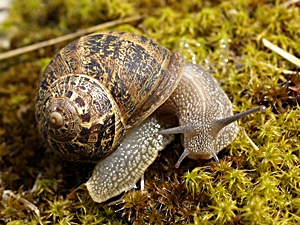
Brown garden snail (Cornu aspersum) from Catalonia.
Picture: Ferrean Turmo Gort (Source).
|
Morphology In biology the subject dealing with the construction and function of creature's body parts is referred to as morphology. In general, like on this page, morphology can be divided into external morphology (the external appearance) and internal morphology (the construction of organs and organ systems). While the external appearance of an animal can be seen by observing, the snail must be killed and dissected to see the internal morphology, which is why organ function is hard to observe in a living animal. |
 Brown garden snail (Cornu aspersum) from Catalonia. Picture: Ferrean Turmo Gort (Source). |
Looking at a snail crawling its way at a proverbial snail's pace, clearly first the difference is seen between the living movable and flexible body, therefore also referred to as the soft body, and the lifeless hard shell.
A snail's soft body externally uniform: It is not divided into segments, like in an articulate animal (like an arthropod (Arthropoda) or a segmented worm (Annelida)). All body parts change into each other invisibly.
In spite of that, a large part of a snail's body can be seen extended outside of the shell, when the snail is crawling around. This body part is flattened at the belly side (ventrally) to form a flat crawling sole and mainly is used for locomotion. This is why it is consequently called the foot. That snails crawl on their belly has provided them with their scientific name: Gastropoda, the belly-foot animals.
The snail can withdraw its foot into the shell by the aid of a large muscle, the retractor muscle. This muscle is fastened at the shell's so called spindle or columella, which is why it is also called the columellar muscle. While the lifeless shell, strictly speaking, is not a part of the body, by their columellar muscle, snails still always remain connected to their shell, unable to leave it. Empty snail shells found in nature are all that remains of a dead snail.
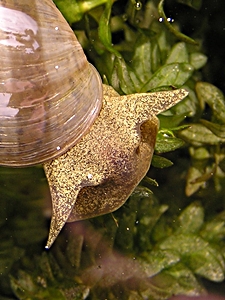 A pond snail's head (Lymnaea stagnalis). [RN] |
At the foot's frontal end, there is the snail's head. Because both are inseparable externally, so they are also referred to as the cephalopodium or head-foot, a recognising character of all snails. At a snail's head there are tactile organs, the so called tentacles. While most terrestrial snails have four tentacles, which they can withdraw (that is a recognising character of terrestrial pulmonate snails (Stylommatophora)), other terrestrial snails, as well as most water snails only possess two tentacles, which they cannot withdraw.
|
Film: A rosy wolf snail (Euglandina rosea) on the prowl. Note the lips' motion! Source: YouTube. |
Especially remarkable are predator snails like the rosy wolf snail (Euglandina rosea), whose lips are extended to form a third tentacle pair. A snail's lips mainly bear sense cells of smell and taste, and wolf snails pursue their prey along its slime thread.
The marine opisthobranchs (Opisthobranchia), on the other hand, have a second pair of tentacles at their disposal, which also mainly holds olfactory sense cells and hence is called rhinophores (nose bearers).
![]() Snails'
tentacles.
Snails'
tentacles.
While a terrestrial pulmonate snail's larger tentacles carry one eye each at the tip, in other snails, such as the fresh water pond snail (Lymnaea stagnalis), the eyes are located at the tentacles' base.
Snails' locomotion is very different and strongly adapted to their way of life. Terrestrial snails' locomotion at a proverbial snail's pace is well known to us. Waves of the foot sole move from tail to head and so carry the snail slowly forward. In doing this the snail always remains in contact with the ground.
Apart from this crawling motion many terrestrial snails are also able to dig (for example the Roman snail digs a hole into the earth to hibernate or to lay its eggs). Water snails not only crawl their way (pond snails for example also can crawl along hanging from the water surface), but there are also swimming forms.
![]() Snails'
locomotion.
Snails'
locomotion.
|
Movie: A brown garden snail (Cornu aspersum). Also note the foam near the aperture area! Source: YouTube. |
Another characteristic attribute is not only important for a snail's locomotion: Snails not only are slow, but also slimy.
A mucus gland produces a slime bed, on which the snail crawls and which it leaves behind as a slime thread. Besides, all of a snail's body is covered in slime.
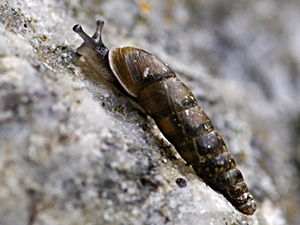 Simplon door snail (Charpentieria dyodon) from Switzerland. Picture: B. Wolf (Source). |
A snail's slime consists of polysaccharides and has astonishing physical properties: Probably the most important of them is hygroscopy: A snail's slime attracts water, because its molecules swell with water. So the slime protects the snail from desiccation. Also, a snail's slime has surprising properties between flexibility and stickiness. For example it reduced friction between the snail's body and the ground, but, together with the sucking action of the foot sole, it also has the snail stick to the ground with surprising force, especially on smooth planes. That explains, how a snail manages to surmount a knife blade, and also, why door snails (Clausiliidae) manage to climb up tree trunks and rocks with their shell giant compared to their foot.
Besides, a snail's slime has still another important protective function: Many snails can foam, when they encounter a predator (such as ants) or if they touch something repulsive. Besides, the slime serves as a protective layer, keeping harmful substances from contact with the body.
Apart from the cephalopodium, always outside of the shell when the snail is crawling around, there is a part of the body always remaining inside the shell. This is called the visceral sac, because many of the snails internal organs are in it, though most of them also extend into the foot. The visceral sac is protected by a stout tissue layer covering its entire surface and called the mantle. The mantle is especially sturdy in the shell aperture, where the danger of evaporation is largest.
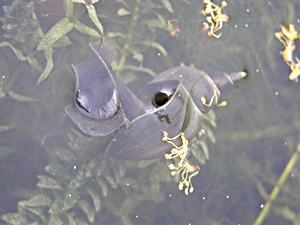 Pond snails (Lymnaea stagnalis) mating. In the right hand snail the pneumostome is well visible. [RN] |
In terrestrial snails and many water snails, in the mantle also the large breathing hole, the pneumostome, can be seen. The respiratory organs of snails can be different, depending on where the snail lives. Basically there are snails with gills, living in the sea and in fresh water, as well as pulmonate snails with lungs, living on land and in fresh water as well.
The ability to breathe air and several other adaptations have induced a very large increase in species numbers by adaptive radiation after snails first set foot on dry land. Today it is estimated, that of about 55,400 species of molluscs (according to Salvini-Plawen, Mizzaro-Wimmer (2001): "Praktische Malakologie" (Practical malacology)) about 43,000 species are snails, of which again about 25,000 are terrestrial pulmonate snails (Stylommatophora) (recalculated following Fechter, Falkner (1990): "Weichtiere" (Molluscs), who take 100,000 mollusc species as a basis).
![]()
![]() Respiration
Respiration
![]() Circulation and excretion
Circulation and excretion
![]() Nutrition
Nutrition
![]() Nervous system
Nervous system
![]() Reproduction.
Reproduction.
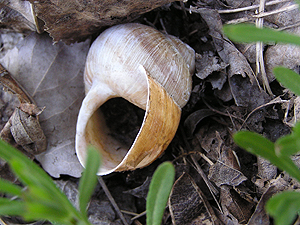 The shell of a Roman snail (Helix pomatia). Picture: [RN]. |
Apart from its protective function to the visceral sac, the mantle has another very important function for the snail: It is tasked with building the shell from lime (calcium carbonate, CaCO3). Snails may hatch from the egg with a small shell already on them, but the shell will not harden until after hatching. With the snail growing, so does the shell. On one hand, lime matter is placed around the aperture, so the shell grows in concentric whorls. On the other hand, lime material is also attached on the inner wall of the shell, which results in the shell walls becoming thicker and resistive. Besides, this lime material can be used to repair damages to the shell.
|
The snail shell is a construction unique in the animal kingdom. It is basically symmetrical, coiled to one side of the body, which makes it distinctly different from a Nautilus shell. As a consequence, it is possible to make the difference between dextral shells coiled to the right and sinistral shells coiled to the left, a character typical for the respective species. There are exceptions to the rule, atypically coiled mutants, which are to referred to as snail kings, at least among Roman snails.
|
|
Picture on the right: From left to right: Bulin snails (Enidae): Jaminia quadridens (sinistral), Zebrina detrita (dextral), door snails (Clausiliidae): Cochlodina laminata and Macrogastra ventricosa (both sinistral). |
Form and colour of the shell among snails are very different, but typical for respective species. Therefore the shell is one of the most important identification characters. On one hand there are roundish shell, such as in helicid snails (Helicidae), on the other there are high shells coiled to a high spindle structure, such as in door snails (Clausiliidae). Shells coiled in a high staircase fashion against the species type are called a scalariform deformity, also known as a teratology.
The outside of the calcium carbonate shell is covered in an organic skin, the periostracum, which protects it against chemical threats of the environment. It also gives the shell its colour and can even bear hairs in some species.
Most marine gastropods and many terrestrial and freshwater snails possess a shell lid, the operculum, which sits on the crawling snail's shell and closes the shell mouth, as soon as the snail withdraws into its shell. Terrestrial pulmonate snails (Stylommatophora) never have an operculum, neither do the marine opisthobranchs (Opisthobranchia), most of which have a more or less reduced shell anyway.
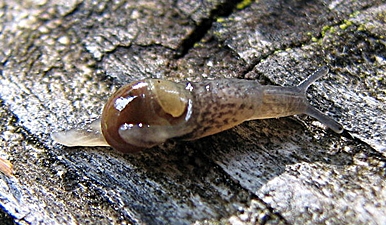 Mountain glass snail (Semilimax kotulae). Picture: Gianbattista Nardi. |
The extraordinary diversity in forms, colours and patterns of snail shells has led to them being assembled in collections for centuries. The richest snail shell collections today can be seen in natural history museums, but there are also some very large private collections.
While originally all gastropods have a shell, among slugs it is reduced during embryonic development. The loss of the shell's protection, on the other hand, gives the slug the advantage of better mobility, especially for subterraneous and predatory slugs. The reduction of the shell (the so called vitrinisation) can be seen in recent snail species in very different evolutionary degrees.
In glass snails (Vitrinidae) for example a growing degree shell reduction is visible, until the snail is rendered unable to withdraw into its shell. Keel back slugs (Limacidae) externally are slugs, but they have a tiny shell rest under their mantle shield. The European round back slugs (Arionidae) on the other hand only possess some calcareous grains left under their mantle shield remaining of the shell. Interestingly, in Northwest America there are the so called jumping slugs (Hemphillia), the weird hunchback appearance of which comes from a small shell they still have beyond their mantle shield. Those, too, are classified as Arionidae.